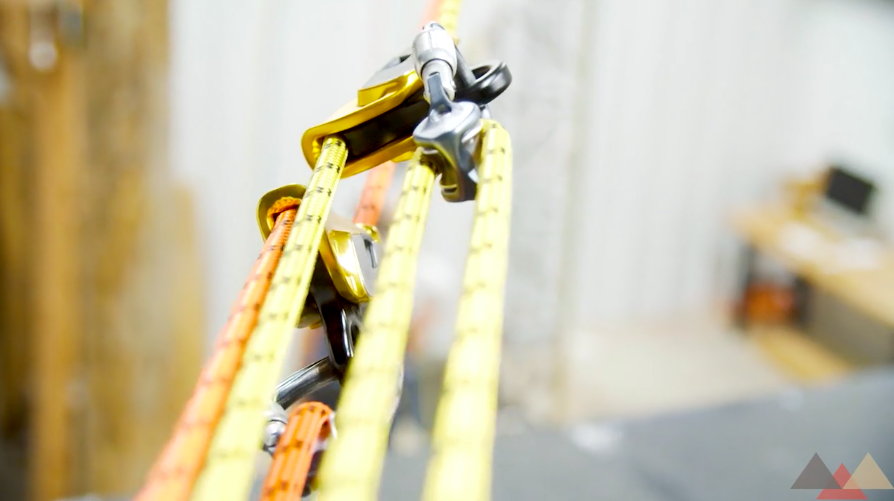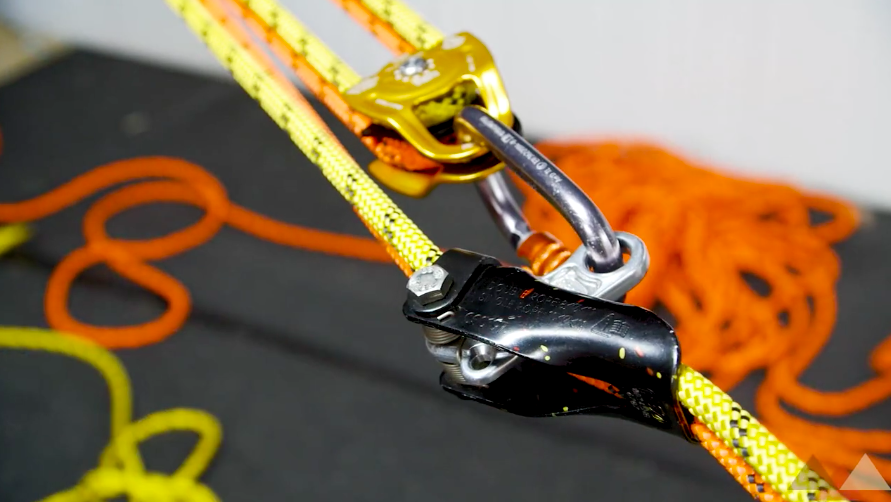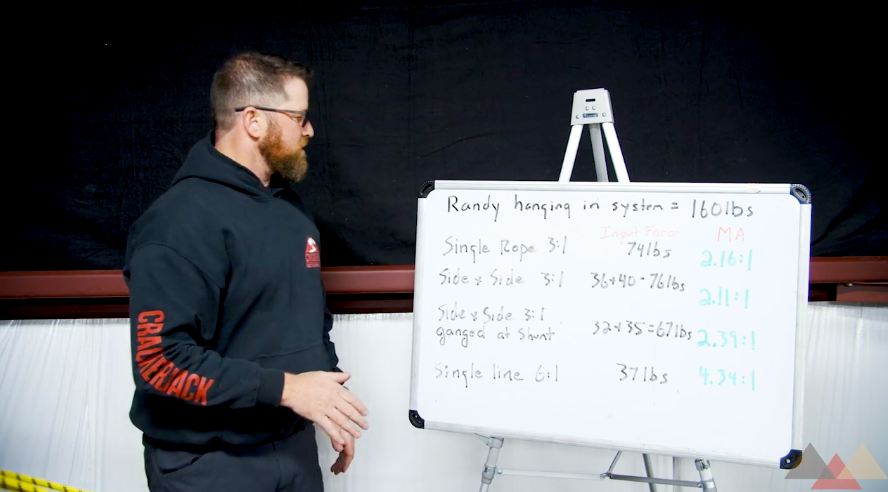Today at Rigging Lab Academy, we’re going to bust this myth that parallel mechanical advantage systems somehow add together and double mechanical advantage. There are arguments out there that two 3:1s side by side pulled on the same load are a 6:1, or two 5:1s are a 10:1. It’s not true, and we’re going to break it down really simply.
Today at the Rigging Lab, we’re going to bust this myth that parallel mechanical advantage systems somehow add together and double mechanical advantage. There are arguments out there that two 3:1s side-by-side pulled on the same load are 6:1, or two 5:1 are 10:1. It’s not true. And we’re going to break it down really simply.
We have Option A. Option A, we have a rope, we hang 180 pound load from it. If we then put a 3:1 on that. Ideally it takes 60 pounds of input force to move that load. I hope we all buy that. So that’s the single rope.
Option B is we have two ropes going to the same load of 180 pounds. How much does each one carry? We know that. Each rope ideally holds 90 pounds. If I put a 3:1 on this one and a 3:1 on this one, and I haul, this side would require 30 pounds, this side would require 30 pounds.
Our combined hauling force looks surprisingly similar to our straight 3:1. One 3:1 on a load, two 3:1s on a load, take the same amount of input force to move the load. Mechanical advantage has not been doubled. All we’ve done is half the force on each rope and half the pulling requirement on each rope, but put together it is still the same 60 pounds of input force required to move the load no matter how many ropes we put in. If you don’t believe me, we’ve set up some testing. We’ll run you through the testing. We’ll show you exactly why that’s true.
We’ve had some questions sent to us and there are a bunch of questions going on online right now that we see about shared tension systems and hauling systems and when you put two haul systems in parallel. Here, we have our yellow rope and our orange rope. We have a 3:1 on each. And some people say, “Well, once you do that, then you have an effective 6:1.” And what we set up today is to disprove that theory.
And we’re going to set up a few different things. We’ll set up just a 3:1 and haul on that. We’ll set up parallel 3:1s haul on those. We’ll tie the ropes together and put two 3:1s on that. And then we’ll set up a true 6:1. And we put load cells in line on each one. We’re monitoring the load cells through the new Enforcer app, which lets us monitor two load cells at the same time. And with real data, we’re going to show you what happens and why two 3:1s running in parallel aren’t effectively a 6:1.
So the first thing we did was we set up our ropes through the redirects we have. We lifted Randy up just on a 1:1 to know what his weight is through the system. Our Randy here is 160 pounds hanging through our system. That’s our baseline number. The second thing we did is we set up just a simple 3:1 through the Rescucender here through the RollClip. We put the load cell on our haul strand and lifted Randy again. And what that told us was it took 74 pounds of input force to lift Randy. So we now know through 3:1, it takes 74 pounds to lift. That gives us our first comparative measurement.
So this is the common setup that we’re dealing with. It’s two lines, equal mechanical advantage on both. Here we have two 3:1s. We’re through the Rescucenders and the RollClips on the haul strand. We have isolated with a short dead leg for the Enforcers to measure. And then just for the purposes of holding stuff static, we put in a redirect with a progress capture here. But as you can see, just two simple 3:1s side-by-side. You can now have the argument, is that a 6:1 or a 3:1? We’ll give you the math later and tell you what it really is.
Another setup people bring up in this conversation is a setup like this that we’re going to do with a Shunt where you tie both ropes together at the haul point and then build your mechanical advantage behind it. So again, we still just have two 3:1s. They’re built off the same master point. We’ll haul on those and we’ll look at what the input forces are. Is it a 3:1 or is it a 6:1?
Our last step was to put in a 6:1 on a single line. We wanted to know what our actual pull force was on a 6:1 so we could compare that back to our different paired 3:1 combinations to see if they really were a 6:1. So we just ganged on a 2:1 onto the haul line of our 3:1, got us a 6:1, and put the Enforcer in on the haul strand. What we got was it took 37 pounds of input force to lift 160 pound Randy, which was a significant difference in other things.
We’re going to get right to the results. Our initial hypothesis in starting this was to disprove that parallel mechanical advantages pulled at the same time don’t double your mechanical advantage. So an example, two 3:1s, a 3:1 in the orange line, a 3:1 in the yellow line, pulled don’t equal a 6:1. A 5:1 and a 5:1 don’t equal a 10:1 and so forth. We set up testing to prove that.
So we knew that Randy hanging through our system is 160 pounds. We have a little bit of friction through the system, but we’re worried about the relationship between the numbers not the absolute numbers. So we know that just on a single 3:1, it took 74 pounds of pull to lift Randy. That gives us an effective 2.16:1 mechanical advantage. We know there’s friction in here. That’s not surprising. Most 3:1s aren’t true 3:1s. This may be a little low, but we’re on target.
We then took the side by side 3:1s. We know we pulled 36 on one, 40 on the other. We had to pull 76 pounds. We had to pull essentially the same amount on a single 3:1 and a double 3:1, giving us almost the same mechanical advantage with a little bit of variance. So this tells us already that a parallel haul system, a two 3:1s pulled next to each other, two 5:1s pulled next to each other, do not double the mechanical advantage. It’s taking the same input force.
To eliminate any questions or arguments about this, we took the next step, which is we tied both ropes together with a Shunt at our tractor point, at our pull point, and pulled on the 3:1s. What that gave us was 32 on 1, 35 on another. 67 pounds of input force to move the load. So we had a little bit less pull here. That could be a bunch of things. It could be the slight imprecision of our setup, or it could be that there’s a slight advantage in friction reduction in how we set up the second one. We did have to change some hardware. We went from a RollClip to a slightly bigger double pulley. That might be the whole difference there. There might be something here, there might not, but it still shows that we didn’t get a 6:1. We’re still inputting about the same amount to move the load as we did on a single 3:1.
So we took the last step and said, “Let’s make sure it’s not a 6:1. Be absolutely sure.” We put in a true 6:1 on one line and it took 37 pounds to move the load. It took essentially half the force to move the load as it did on a 3:1, showing what a true 6:1 felt like it. It was really a 4.34:1, but it was still twice the mechanical advantage of a single 3:1, twice the mechanical advantage of parallel 3:1s, twice the mechanical advantage of gang 3:1s. That’s a 6:1.
So to be totally clear in all of this, we can throw all the stuff out the window now. Parallel 3:1s, gang 3:1s, parallel hauls, no matter what you do you’re not doubling your mechanical advantage, you’re just halving the force on each rope, halving the amount of pull you have to have in each rope. You still have to put in the same amount of work to get the job done. You’re just deciding on what rope you put it on.
Peace on your Days…
Lance













7 thoughts on “Parallel Hauls, Doubled Mechanical Advantage or Not?”
Thanks for doing this test. I don’t disagree with the findings but I think you guys focused a little tightly on the numbers and not the real world benefits of this setup. The load weighs what it weighs and the energy to move the load is a product of how gravity and the components are interacting with one another, those will always be the starting point. Halving the input force on each of the ropes requires much less coordination and effort on the haulers. I would never gang them together as this negates that benefit. The biggest advantage of the twin 3:1 system is the rate at which it collapses. Less resets, longer throw. Couple that with the haulers being able to hand over hand the ropes providing a smoother ride for the victim and maybe an attendant and this has been a tremendous improvement over a single Z rig or inline 5:1 used in most haul systems.
176870 180008I discovered your blog post internet website on the search engines and appearance several of your early posts. Always maintain the top notch operate. I additional the Feed to my MSN News Reader. Seeking forward to reading much a lot more on your part down the line! 846336
488655 874992Maximize your by how a large amount of gear are employed internationally and will often impart numerous memory using that your is also fighting that is really a result from our team rrnside the twenty very first centuries. everyday deal livingsocial discount baltimore washington 662891
365856 661395So, is this just for men, just for girls, or is it for both sexes If it s not, then do ladies need to have to do anything different to put on muscle 397991
914685 438564i was just surfing along and came upon your blog. just wanted to say good job and this post genuinely helped me. 695424
642556 472133Get started with wales ahead nearly every planking. Ones wales truly are a compilation of huge planks one specific depth advisors surely could be the identical towards the entire hull planking even so with even larger density to successfully thrust outward beyond the planking. planking 598004
562809 794115Visiting begin a business venture about the internet usually means exposing your products or services moreover provider not only to some individuals inside your town, but however to lots of future prospects who may possibly be over the web many times. straightforward internet business 56816
Comments are closed.